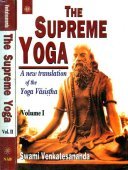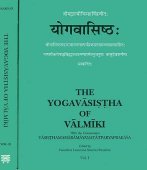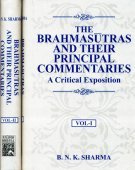Vairagya, Vairāgya: 24 definitions
Introduction:
Vairagya means something in Hinduism, Sanskrit, Jainism, Prakrit, Marathi, Hindi. If you want to know the exact meaning, history, etymology or English translation of this term then check out the descriptions on this page. Add your comment or reference to a book if you want to contribute to this summary article.
Alternative spellings of this word include Vairagy.
In Hinduism
Vaishnavism (Vaishava dharma)
Source: ISKCON Press: GlossaryVairāgya (वैराग्य).—Renunciation; detachment from matter and engagement of the mind in spirit.
Source: Pure Bhakti: Bhagavad-gita (4th edition)Vairāgya (वैराग्य) refers to “(1) Detachment from this world (2) Spiritual discipline involving voluntary austerities to achieve detachment from the objects of the senses”. (cf. Glossary page from Śrīmad-Bhagavad-Gītā).
Source: Pure Bhakti: Brhad BhagavatamrtamVairāgya (वैराग्य) refers to:—Renunciation, detachment, or indifference to this world; a spiritual discipline involving acceptance of voluntary austerities to achieve detachment from sense objects. (cf. Glossary page from Śrī Bṛhad-bhāgavatāmṛta).
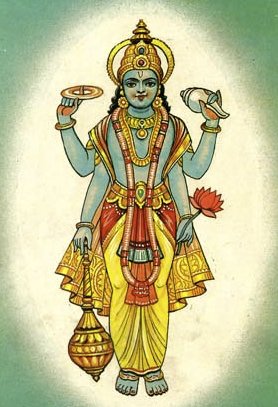
Vaishnava (वैष्णव, vaiṣṇava) or vaishnavism (vaiṣṇavism) represents a tradition of Hinduism worshipping Vishnu as the supreme Lord. Similar to the Shaktism and Shaivism traditions, Vaishnavism also developed as an individual movement, famous for its exposition of the dashavatara (‘ten avatars of Vishnu’).
Purana and Itihasa (epic history)
Source: archive.org: Shiva Purana - English TranslationVairāgya (वैराग्य) refers to “non-attachment”, according to the Śivapurāṇa 1.13.—Accordingly, “from virtue wealth is derived and from wealth enjoyment. Vairāgya (non-attachment) is the outcome of enjoyment. That is to say, when one fully enjoys the pleasures by means of wealth acquired by virtuous means one comes to the stage of Vairāgya (Detached State). If the enjoyment is through the wealth acquired by other means, the result is the increase of passion alone”.
Source: Cologne Digital Sanskrit Dictionaries: The Purana IndexVairāgya (वैराग्य).—Detachment and devotion to jñāna; leads to purification of body and mind. One such person becomes a nirmama.*
- * Brahmāṇḍa-purāṇa III. 4. 10; IV. 3. 45, 60; Vāyu-purāṇa 57. 117; 102. 66, 82; 104. 15.

The Purana (पुराण, purāṇas) refers to Sanskrit literature preserving ancient India’s vast cultural history, including historical legends, religious ceremonies, various arts and sciences. The eighteen mahapuranas total over 400,000 shlokas (metrical couplets) and date to at least several centuries BCE.
Vedanta (school of philosophy)
Source: Shodhganga: Siva Gita A Critical StudyVairāgya (वैराग्य) refers to “dispassion”, “aversion” or “freedom from passion”.—Vairāgya is distate or disgust for worldliness because of spiritual awakening. Also, the constant renunciation of obstacles on the path to liberation. Ascetic or monastic life.
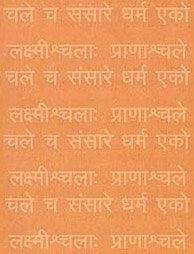
Vedanta (वेदान्त, vedānta) refers to a school of orthodox Hindu philosophy (astika), drawing its subject-matter from the Upanishads. There are a number of sub-schools of Vedanta, however all of them expound on the basic teaching of the ultimate reality (brahman) and liberation (moksha) of the individual soul (atman).
Shaivism (Shaiva philosophy)
Source: Brill: Śaivism and the Tantric TraditionsVairāgya (वैराग्य) refers to “indifference” (which destroys attachment), according to the Vārāṇasīmāhātmya verse 1.99ff.—Pulastya also reports that there is a pond there called Kālodaka, which arose when Kālarudra was playing on the cremation ground. At that time the Lord taught the observance of the skull (kapālavrata). He chopped off the fifth head of Brahmā, as a consequence of which there arose the holy Pāśupata pond. Mahādeva subsequently carries Brahmā’s skull around the world and unites with the cremation grounds. There he teaches that transmigration results from attachment (sneha), that attachment comes from desire (rāga), and that attachment is destroyed by indifference (vairāgya). When people attain indifference, their karma is destroyed and they attain unequalled happiness (saukhya). [...]

Shaiva (शैव, śaiva) or Shaivism (śaivism) represents a tradition of Hinduism worshiping Shiva as the supreme being. Closely related to Shaktism, Shaiva literature includes a range of scriptures, including Tantras, while the root of this tradition may be traced back to the ancient Vedas.
Yoga (school of philosophy)
Source: ORA: Amanaska (king of all yogas): A Critical Edition and Annotated Translation by Jason BirchVairāgya (वैराग्य) refers to “detachment ”, according to the Niśvāsakārikā verse 32.149cd-152.—Accordingly, while discussing the character of teachings on no-mind: “The goddess asked: ‘What is [the benefit] of this yoga of detachment (vairāgya); is Siddhi [obtained by it] or not? I desire to know this, O Lord, please tell [me]’. The Lord said: ‘O goddess, listen to the supreme secret [teaching] and its unsurpassed Siddhi. It has no form, no colour and no meditation. It is both with and without aspects. It lacks anything through which it can be acted upon and it has no location. [This] great no-mind yoga is not a division of [mantra] recitation, is free from form and colour [but] gives all Siddhis’”.

Yoga is originally considered a branch of Hindu philosophy (astika), but both ancient and modern Yoga combine the physical, mental and spiritual. Yoga teaches various physical techniques also known as āsanas (postures), used for various purposes (eg., meditation, contemplation, relaxation).
General definition (in Hinduism)
Source: WikiPedia: HinduismVairāgya roughly translates as dispassion, detachment, or renunciation, in particular renunciation from the pains and pleasures in the material world (Maya). The Hindu philosophers who advocated vairāgya told their followers that it is a means to achieve moksha. True vairagya refers to an internal state of mind rather than to external lifestyle and can be practiced equally well by one engaged in family life and career as it can be by a renunciate. Vairagya does not mean suppression or developing repulsion for material objects. By the application of vivek (spiritual discrimination or discernment) to life experience, the aspirant gradually develops a strong attraction for the inner spiritual source of fulfillment and happiness and limited attachments fall away naturally. Balance is maintained between the inner spiritual state and one's external life through the practice of seeing all limited entities as expressions of the one Cosmic Consciousness or Brahman.
The concept of Vairāgya is found in the Yoga Sūtras of Patañjali, where it along with practice (abhyāsa), is the key to restraint of the modifications of the mind (YS 1.12, "abhyāsa-vairāgyabhyāṃ tannirodhaḥ"). The term vairāgya appears three times in the Bhagavad Gita (6.35, 13.8, 18.52) where it is recommended as a key means for bringing control to the restless mind. It is also the main topic of Mokṣopāya or Yoga Vasistha. Another important text on renunciation is Vairāgya shataka or "100 verses of Renunciation", a part of the Śatakatraya collection by Bhartṛhari.
Etymology: Vairāgya is an abstract noun derived from the word virāga (joining vi meaning "without" + rāga meaning "passion, feeling, emotion, interest"). This gives vairāgya a general meaning of ascetic disinterest in things that would cause attachment in most people. It is a "dis-passionate" stance on life. An ascetic who has subdued all passions and desires is called a vairāgika.
In Jainism
General definition (in Jainism)
Source: Encyclopedia of Jainism: Tattvartha Sutra 7: The Five VowsVairāgya (वैराग्य, “detachment”) according to the 2nd-century Tattvārthasūtra 7.12.—What is meant by detachment (vairāgya)? To develop disinterest towards the subjects of the sensual and physical pleasures is detachment.
Source: The University of Sydney: A study of the Twelve ReflectionsVairāgya (वैराग्य) refers to “non-attachment”, according to the 11th century Jñānārṇava, a treatise on Jain Yoga in roughly 2200 Sanskrit verses composed by Śubhacandra.—Accordingly, “Further, for the complete attainment of the desire for liberation, non-attachment (vairāgya), restraint and tranquillity, those [twelve reflections] are tied to the post of the mind by mendicants desiring liberation”.
Synonyms: Nirveda.
Source: academia.edu: Tessitori Collection IVairāgya (वैराग्य) refers to one of the topics dealt with in the Sadbhāṣitāvalī by Sakalakīrti (classified as gnomic literature), which is included in the collection of manuscripts at the ‘Vincenzo Joppi’ library, collected by Luigi Pio Tessitori during his visit to Rajasthan between 1914 and 1919.—In the Udine manuscript verses are marked by exhortations in imperative which are sometimes emphasized with orange pigment: [e.g., vairāgya—vairāgyaṃ kuru (4r15)]

Jainism is an Indian religion of Dharma whose doctrine revolves around harmlessness (ahimsa) towards every living being. The two major branches (Digambara and Svetambara) of Jainism stimulate self-control (or, shramana, ‘self-reliance’) and spiritual development through a path of peace for the soul to progess to the ultimate goal.
Languages of India and abroad
Marathi-English dictionary
Source: DDSA: The Molesworth Marathi and English Dictionaryvairāgya (वैराग्य).—n S Absence of worldly desire or passion. 2 Popularly. Renunciation of all sensuous delight or gratification.
Source: DDSA: The Aryabhusan school dictionary, Marathi-Englishvairāgya (वैराग्य).—n Absence of worldly desire or passion.
Marathi is an Indo-European language having over 70 million native speakers people in (predominantly) Maharashtra India. Marathi, like many other Indo-Aryan languages, evolved from early forms of Prakrit, which itself is a subset of Sanskrit, one of the most ancient languages of the world.
Sanskrit dictionary
Source: DDSA: The practical Sanskrit-English dictionaryVairāgya (वैराग्य).—[virāgasya bhāvaḥ ṣyañ]
1) Absence of worldly desires or passions, indifference to the world, asceticism; अभ्यासेन च कौन्तेय वैराग्येण च गृह्यते (abhyāsena ca kaunteya vairāgyeṇa ca gṛhyate) Bhagavadgītā (Bombay) 6.35;13.8.
2) Dissatisfaction, displeasure, discontent; कामं प्रकृति- वैराग्यं सद्यः शमयितुं क्षमः (kāmaṃ prakṛti- vairāgyaṃ sadyaḥ śamayituṃ kṣamaḥ) R.17.55.
3) Aversion, dislike.
4) Grief, sorrow.
5) Change or loss of colour.
Derivable forms: vairāgyam (वैराग्यम्).
Source: Cologne Digital Sanskrit Dictionaries: Shabda-Sagara Sanskrit-English DictionaryVairāgya (वैराग्य).—n.
(-gyaṃ) Subjection of the appetite and passions, absence of worldly desires. E. virāga and ṣyañ aff.: see vairāga .
Source: Cologne Digital Sanskrit Dictionaries: Benfey Sanskrit-English DictionaryVairāgya (वैराग्य).—i. e. vi-rāga + ya, n. 1. Absence of worldly desire, [Bhagavadgītā, (ed. Schlegel.)] 6, 35 (devotion); [Pañcatantra] 50, 16. 2. Disaffection, [Hitopadeśa] iii. [distich] 90. 3. Sorrow, [Pañcatantra] 82, 13; 116, 11. 4. Despondency, 235, 11.
Source: Cologne Digital Sanskrit Dictionaries: Cappeller Sanskrit-English DictionaryVairāgya (वैराग्य).—[neuter] losing colour or turning pale; absence of passion, indifference, repugnance.
Source: Cologne Digital Sanskrit Dictionaries: Monier-Williams Sanskrit-English Dictionary1) Vairāgya (वैराग्य):—[from vairāga] n. change or loss of colour, growing pale, [Suśruta; Kāmandakīya-nītisāra]
2) [v.s. ...] disgust, aversion, distaste for or loathing of ([locative case] [ablative], or [compound]), [Bhagavad-gītā; Raghuvaṃśa] etc.
3) [v.s. ...] freedom from all worldly desires, indifference to worldly objects and to life, asceticism, [Upaniṣad; Mahābhārata etc.]
Source: Cologne Digital Sanskrit Dictionaries: Yates Sanskrit-English DictionaryVairāgya (वैराग्य):—(gyaṃ) 1. n. Absence of worldly passion or desire.
Source: DDSA: Paia-sadda-mahannavo; a comprehensive Prakrit Hindi dictionary (S)Vairāgya (वैराग्य) in the Sanskrit language is related to the Prakrit words: Vairāga, Veragga.
[Sanskrit to German]
Sanskrit, also spelled संस्कृतम् (saṃskṛtam), is an ancient language of India commonly seen as the grandmother of the Indo-European language family (even English!). Closely allied with Prakrit and Pali, Sanskrit is more exhaustive in both grammar and terms and has the most extensive collection of literature in the world, greatly surpassing its sister-languages Greek and Latin.
Hindi dictionary
Source: DDSA: A practical Hindi-English dictionaryVairāgya (वैराग्य) [Also spelled vairagy]:—(nm) (attitude of) renunciation, detachment (from worldly affairs); -[bhāva]([nā]); spirit of renunciation/detachment.
...
Kannada-English dictionary
Source: Alar: Kannada-English corpusVairāgya (ವೈರಾಗ್ಯ):—[noun] the quality, state or fact of being not influenced by personal interest, selfish motives, sensual enjoyments, worldly possessions, etc.
Kannada is a Dravidian language (as opposed to the Indo-European language family) mainly spoken in the southwestern region of India.
See also (Relevant definitions)
Starts with: Vairagyabhyasa, Vairagyabijamantra, Vairagyacandrika, Vairagyadvara, Vairagyamala, Vairagyanashin, Vairagyanashini, Vairagyapadavi, Vairagyapancaka, Vairagyapancashiti, Vairagyapradipa, Vairagyaprakarana, Vairagyaratna, Vairagyasamjna, Vairagyashataka, Vairagyata, Vairagyayoga.
Ends with: Abhavavairagya, Akshivairagya, Aparavairagya, Avairagya, Dehavairagya, Jnanavairagya, Koradem Vairagya, Koradem-vairagya, Maithunavairagya, Manasavairagya, Prasutivairagya, Puranavairagya, Samsaravairagya, Shmashanavairagya, Svabhavavairagya, Udaravairagya.
Full-text (+81): Vairagyata, Vairaga, Pratyapatti, Aparavairagya, Maithunavairagya, Vairagyashataka, Vairagin, Shmashanavairagya, Bhartrihari, Vairagyapancashiti, Vairagyapradipa, Vairagyaratna, Savairagyam, Vairagyacandrika, Vairagyapancaka, Vairagyaprakarana, Bairag, Sadhricina, Dridhay, Vibhi.
Relevant text
Search found 89 books and stories containing Vairagya, Vairāgya; (plurals include: Vairagyas, Vairāgyas). You can also click to the full overview containing English textual excerpts. Below are direct links for the most relevant articles:
Chaitanya Bhagavata (by Bhumipati Dāsa)
Verse 1.1.154 < [Chapter 1 - Summary of Lord Gaura’s Pastimes]
Verse 2.7.99 < [Chapter 7 - The Meeting of Gadādhara and Puṇḍarīka]
Verse 2.24.92 < [Chapter 24 - The Lord Displays His Universal Form to Advaita]
Shiva Gita (study and summary) (by K. V. Anantharaman)
Appendix 6 - The Concept of Vairāgya Abhijñāna Śākuntala
Chapter 2 - The Teaching of Dispassion (vairāgya-upadeśa)
Chapter 8 - Origin and Development of Foetus or Embryo (piṇḍotpatti-kathana)
Brihad Bhagavatamrita (commentary) (by Śrī Śrīmad Bhaktivedānta Nārāyana Gosvāmī Mahārāja)
Verse 2.2.205 < [Chapter 2 - Jñāna (knowledge)]
Chapter 1 - Vairāgya (renunciation) < [Part two - Prathama-khaṇḍa]
Verse 2.2.102 < [Chapter 2 - Jñāna (knowledge)]
Bhajana-Rahasya (by Srila Bhaktivinoda Thakura Mahasaya)
Text 24 < [Chapter 2 - Dvitīya-yāma-sādhana (Prātaḥ-kālīya-bhajana)]
Text 38 < [Chapter 2 - Dvitīya-yāma-sādhana (Prātaḥ-kālīya-bhajana)]
Text 14 < [Chapter 2 - Dvitīya-yāma-sādhana (Prātaḥ-kālīya-bhajana)]
Bhakti-rasamrta-sindhu (by Śrīla Rūpa Gosvāmī)
Verse 1.2.256 < [Part 2 - Devotional Service in Practice (sādhana-bhakti)]
Verse 1.2.255 < [Part 2 - Devotional Service in Practice (sādhana-bhakti)]
Verse 1.2.250 < [Part 2 - Devotional Service in Practice (sādhana-bhakti)]
Garga Samhita (English) (by Danavir Goswami)
Verses 6.19.11-13 < [Chapter 19 - In the First Fortress of Dvārakā, the Glories of Līlā-sarovara, etc.]
Verse 2.9.10 < [Chapter 9 - Brahmā’s Prayers]
Related products
